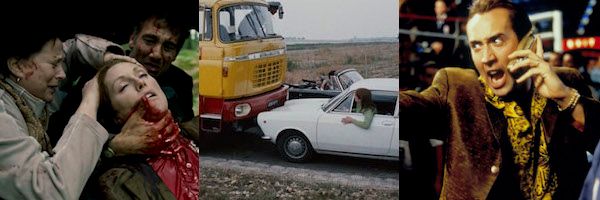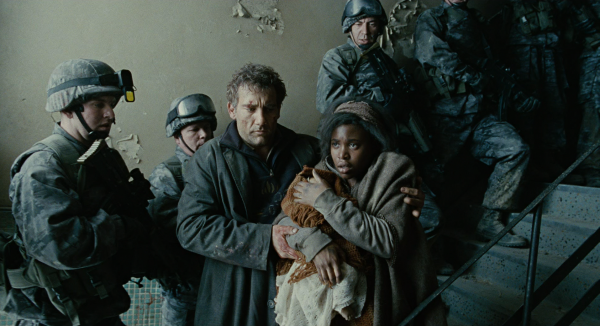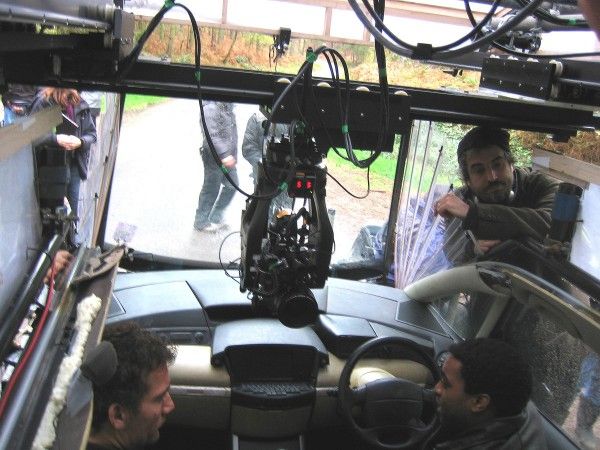Children of Men wasn’t the first film to stage lengthy scenes with intricate camera movements all contained within one shot, but it was certainly a game changer. For decades, directors had orchestrated many breathtaking shots with people moving in and out of the frame, intricately timed as a camera moves on a crane, track or steadicam. However, none contained as much violence and carnage as Men was able to display in lengthy shots that required days of orchestration to time explosions, bullets, motorcycles and charging counterrevolutionaries.
Children of Men was the most elaborate big budget film that had multiple long orchestrated takes—and it is still a stunning achievement. 10 years later, the long take that packs in massive carnage with shifting camera vantage points become a common part of action filmmaking. It’s easy to understand why. By not cutting there’s an adrenaline rush and tightening tension that occurs that makes viewers feel like they’re witnessing the events in real time. There are no cuts to weapons, fists, expressions, to provide extra context or a break from said tension; instead it’s viscerally present, all in one moment.
Children of Men’s two biggest pieces—a surprise attack on a car that’s holding revolutionaries who are escorting the first woman to become pregnant after a decade of worldwide infertility, and an extensive battle within a bombed out building—required days to set up. For the car chase, the crew had the location for that shot for 12 days. 10 days were spent getting the camera axes correct on the car rig, placing the attackers in their proper places to enter the shot after launching a fiery roadblock, charge the car, back up the car, send a motorcycle toward the car to fire, crash and then pan back around to reveal one of the most shocking early deaths of a well known actor ever filmed. That doesn’t even include the beginning portion of the scene where two former lovers, Clive Owen and Julianne Moore, play a charming parlor trick involving a ping-pong ball to lull the viewer into feeling safe before the attack. It took 10 days to set up all those human and camera movements, which gave them only two days to shoot. And due to all those movements, director Alfonso Cuaron could only attempt three total shots due to the reset time over two days to get it.
Rather famously, in another, longer set-up for the shootout at the end, when the camera moves through a building during a battle, Alfonso Cuaron yelled cut when blood hit the camera but the crew didn’t hear him due to all the sounds from the action they were capturing, so they kept rolling and that bloody take is what we have in the film. Days of preparation and timing of specific movements were spent on getting both of these elaborate shots. Both are integral moments in the film and it’s hugely impressive that they were pulled off with only a few tries to get while filming. But the result is much more than a showiness of technical proficiency. These long takes enhance the narrative by creating an immense and consistent feeling that something can go wrong at any moment because the long take maintains a level of discomfort without a release until the threat of the attack is over. The two mentioned set pieces are the biggest, but Cuaron uses the long take throughout the film, whenever a physical threat is coming. A video essay of every shot in Children of Men that lasts longer than 45 seconds (viewable at the bottom of this page) clocks in at 32 minutes, or ¼ of the film’s total runtime. The tension is constant.
The very cinematographer who pulled off some of the biggest camera feats of all time on that film, three-time Oscar-winner Emmanuel Lubezki (who shockingly didn’t win for Children of Men), has since gone on to shoot many more elaborate long takes with Gravity, Birdman and The Revenant. But as the thirst for the complex long take has increased, the line has blurred more in the past decade of what constitutes a pure long take. Cinematographers consistently use scripted edit points to create shots where there’d be a natural cut that could seamlessly combine two takes and still appear like it all occurred in one take (see: Birdman taking that approach to make an entire film look like one continuous take, and True Detective’s epic six-minute escape from a drug den to the streets which features two built-in edits that went unused but were plain to see where they could have been used, like the pan up to the helicopters, to make it appear like a long take even if it were two shots).
For cinema’s first 50 years, it was impossible to have shots that would last as long as almost all of the long takes in Cuaron’s 2006 film—because cameras could only hold 1000 feet of film (10 minutes) before it was unable to reload more film. Long before Birdman, Alfred Hitchcock wanted Rope to look like one continuous shot, so he shot ten minutes at a time, a whole role of film, ending each shot on a flat surface and then zooming out when the new reel was loaded. There are 11 shots in the film. Since Hitchcock’s experiment, the long take has largely been favored by an auteur who’s earned enough goodwill to be entrusted with a shot that would take a whole production day (or more) to set up (such as Martin Scorsese, Brian De Palma, Robert Altman, Robert Zemeckis and Michelangelo Antonioni) and frequently it was used for glorious intros to many characters at once or an outro of a darkness enveloping our main characters. However, post Children of Men the long take has become a desired built in trait for many action and thriller films and many crews are more formally trained to pull it off.
Since Children of Men has greatly influenced the blockbuster use of the long take, on its 10-year anniversary we’ve decided to look at some of the best long takes that pre-dated and perhaps influenced the film. Although the shots below contain less violence and over-boiling tension, there is a commonality in how much information they relay to the audience to create a sense of growing unease.
Peruse our list and let us know which is your personal favorite long take from Children of Men. Which are your favorite post-Men? And how’d we fare on our roundup of the best long takes that pre-dated 2006’s monolithic achievement, Children of Men.
'Rope' (1948): 10 Shots
Made up of only ten shots, each one ranging from seven to ten minutes, Rope is one of Alfred Hitchcock’s great formal feature-length experiments, matched by his meticulous, marvelous framings for Dial M for Murder in 3D. Any one of these shots plays as micro-masterclass in visual storytelling, but my favorite remains the opening stretch, in which two students hide the body of a classmate that they have no sympathy for whatsoever and the ensuing cleaning up of the space. The shot opens with the young man dying, the rope still around his neck, and from there becomes a thrilling, detailed process of straightening up. The work Hitchcock does here might be tossed away as a gimmick, but his technical know-how and patience also evoke an immediate narrative urgency and an attention to detail from the audience that matches the two murderers, placing our sympathies with the killers rather than the victim. — Chris Cabin
'Touch of Evil' (1958): Opening Crane Shot
Orson Welles opened Touch of Evil with the most elaborately complex shot of the time period. Russell Metty’s camera moves from a close up to a ticking bomb and then is slowly raised by a crane that locates Charlton Heston as he wanders a Mexican street, gets lost in the crowd and infrastructure and then emerges again to kiss Janet Leigh at the same time an explosion occurs. The crane movement is graceful and the production design is impeccable, but the magic of the shot is heightened showing the bomb first because it subconsciously forces the audience to follow and re-find Heston once he’s established after seeing the bomb. When we find him in his car with Leigh the crane shot impressively follows for a long period and seamlessly lowers to ground level as the lovebirds stop in town. There’s something voyeuristic about tracking him, too, there’s a suspicion that Welles wants you to feel but there’s no evidence. The kiss, of course, is the joy of life at the exact moment that death hits close by. — Brian Formo
'Week End' (1967): Traffic Jam
In terms of camera movement, this seven-minute tracking shot from Jean-Luc Godard isn’t complicated: it just tracks sideways without changing speed. What makes this shot legendary however is the staging done that’s by Godard. Cars, humans and animals stretch down a roadway for a slow camera crawl. It begins very quaint, with picnics on the side of the road. Then car horns begin sounding and we realize that everyone is out of their car because they’d given up on moving any further. Because Godard’s non-narrative black comedy of upper-crust chaos follows Mireille Darc and Jean Yanne as they’re making their way to the country, we assume that the holdup is just the bourgeoisie all having the same plan to go away to the country for the weekend. And though that may be the case, it gets much darker the longer Raoul Coutard’s camera tracks. Eventually we start seeing blood and dead bodies strewn about.
The constant honking and the little glimpses into the lives on the road is reminiscent of Jacques Tati’s whimsical films; like Tati, Godard is critical of bourgeoisie entitlement, but Godard slowly pulls the yarn away from whimsy and leads us to witness something terrible. People slow down at a car wreck to see what happened. What happened here is that capitalism created a type of race that could only lead to death and human displacement from their desired pathways. — Brian Formo
'The Passenger' (1975): Ending
This is a very patient shot with a big surprise as the camera starts as an observer and then it moves metal out of its way to get a less obstructed view of what’s happening in a courtyard while a death occurs off screen. How Michelangelo Antonioni and his director of photography, Luciano Tovoli, achieved the push through the window bars after already establishing their firm foundation in Jack Nicholson’s hotel room is mysterious—but it also perfectly fits this road trip film where identities switch and enigmatic questions of the universe hatch. We’re just along for the ride. — Brian Formo
'Goodfellas' (1990): A Night at the Copacabana
One of the legends of long takes, Scorsese’s ambitious tracking shot that apparently was “in the can before lunch” despite its monumental scale works not just because it’s a jaw-dropping example of the power of cinema (because it is), but because it’s one of the film’s most efficient emotional arcs, revealing Henry Hill (Ray Liotta)’s sumptuous and money-padded existence inside the Copacabana as seen through Karen (Lorraine Bracco)’s eyes. Buzzing with energy and the gleam of new money, Scorsese’s three-minute flourish isn’t the most action-packed sequence of the movie but it is one of the finest examples of the gorgeous and evocative visual storytelling we’ve come to expect from the master. — Aubrey Page
'Boogie Nights' (1997): The Reseda Opening
Long takes have since become Paul Thomas Anderson’s bread and butter since the cinematic wunderkind made his first indelible mark on cinema with the ‘70s epic Boogie Nights, but when the young director made the bold decision to open his sophomore effort with a three-minute tracking shot, there was no question of his new talent. Effortlessly introducing his immense cast in one sweeping, energetic shot that smashes in with a bouncy disco track and whirls impossibly outwards across a sweaty California street and into a smoke-filled lounge. Debuting its tragic figures in an impossibly glamorous light, we finally find Eddie Adams (Mark Wahlberg, the soon-to-be porn megastar Dirk Diggler) as the camera languishes over him, slowly bussing tables amidst the dancey mania. Begging you to want more, it’s at that exact moment that PTA cuts. — Aubrey Page
'Snake Eyes' (1998): Opening Shot
Brian De Palma is inarguably Hitchcock’s most profoundly dedicated acolyte, and with the opening shot of Snake Eyes, clocking in at 12 minutes, he attempted to one-up the master’s myriad thoughtful long takes in the aforementioned Rope. De Palma opens this pulpy, immediate tale of an assassination at a boxing match by giving us a full view of the corridors, backrooms, nooks, and crannies of the arena in which all the action takes place. Nicolas Cage’s hustling dirty cop acts as our guide, and the sustained yet antic shot seems to mirror his anxious, inventive performance, in both the character’s physical and intellectual stimulus. The script is a boilerplate whodunit, but this opening sequence and the ensuing series of formal flourishes that De Palma uses to mirror a myriad of perspectives make Snake Eyes a minor masterpiece of sorts. — Chris Cabin
'Werckmeister Harmonies' (2000): The Opening
Bela Tarr is the modern master of the long take. Each one of his films features a stunningly economic amount of shots, and yet each shot is filled with such uproars of life and encompassing, atmospheric gloom that you don’t miss the cuts. The Turin Horse features some of Tarr’s best work, but for my money, the opening sequence of Werckmeister Harmonies, his staggering 2000 opus about an inanimate whale and the town that surrounds it. Here, we get a full sense of the drunk, dreary community as the local pub is preparing to close for the night. We meet resident poet Valuska, who becomes central to the film’s meager yet mighty drama, but it’s in the fluidity and confidence of the take that Tarr’s film begins to get its tentacles around you. His movies show an undiluted sense of bearing witness in the present, taking in the world around you at a constant, rarely distracted clip. The feeling that it yields is something close to wonder. — Chris Cabin
'Elephant' (2003): Walking to Class
Gus Van Sant repeats a simple motif throughout Elephant: he and Harris Savides follow behind a student as they make their way into a high school building. It is simple, but the steadicam follows contain a lot of information in their simplicity—the different groups of students and how they dress and compose themselves in different tribes of athletes, skaters, mallrats, etc. The commonality between all the groups is that they’re relaxed and in no hurry. There’s a specific that viewers can relate with: being at school but holding on to as much non-school time as possible in each break that’s given. This laziness is broken however when two students dressed in camouflage gear walk briskly toward the building with duffle bags full of guns. Because Van Sant and Savides follow them from behind the same way that they did the students who will either be massacred or witness a massacre there’s an understanding that tragedy rushes up on us and it disrupts the mundane in a shocking way. — Brian Formo
'Oldboy' (2004): Elevator Fight Scene
The one-man army is a classic cinema trope; a kinetic fantasy of power, determination, and grit. In Oldboy, Park Chan-wook turns the fantasy into a nightmare with a single, simple 3-minute tracking shot that pits our tormented antihero Dae-su (Min-sik Choi) against a hallway full of armed goons with nothing but a hammer and sheer force of will. The stripped down framing gives the shot strength, letting the unpolished melee take center stage as Dae-su claws and grapples his way through the crowd, taking some beatings, and even a knife in the back along the way. He stutters, he falters, he falls and rises as he slowly thins the herd, and Park keeps the camera at a steady distance all the while, giving the fight the clearest possible sense of geography and choreography that makes it feel like you're watching one many single-handedly turn back the tide. — Haleigh Foutch
Every 45-Second or Longer Shot in 'Children of Men' (2006)
Children of Men - every shot 45 seconds or longer from Refocused Media on Vimeo.



